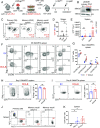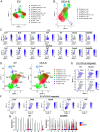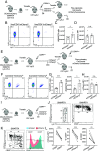OCA-B/Pou2af1 is sufficient to promote CD4+ T cell memory and prospectively identifies memory precursors
- PMID: 38386711
- PMCID: PMC10907311
- DOI: 10.1073/pnas.2309153121
OCA-B/Pou2af1 is sufficient to promote CD4+ T cell memory and prospectively identifies memory precursors
Erratum in
-
Correction for Sun et al., OCA-B/Pou2af1 is sufficient to promote CD4+ T cell memory and prospectively identifies memory precursors.Proc Natl Acad Sci U S A. 2024 Apr 16;121(16):e2405830121. doi: 10.1073/pnas.2405830121. Epub 2024 Apr 8. Proc Natl Acad Sci U S A. 2024. PMID: 38588436 Free PMC article. No abstract available.
Abstract
The molecular mechanisms leading to the establishment of immunological memory are inadequately understood, limiting the development of effective vaccines and durable antitumor immune therapies. Here, we show that ectopic OCA-B expression is sufficient to improve antiviral memory recall responses, while having minimal effects on primary effector responses. At peak viral response, short-lived effector T cell populations are expanded but show increased Gadd45b and Socs2 expression, while memory precursor effector cells show increased expression of Bcl2, Il7r, and Tcf7 on a per-cell basis. Using an OCA-B mCherry reporter mouse line, we observe high OCA-B expression in CD4+ central memory T cells. We show that early in viral infection, endogenously elevated OCA-B expression prospectively identifies memory precursor cells with increased survival capability and memory recall potential. Cumulatively, the results demonstrate that OCA-B is both necessary and sufficient to promote CD4 T cell memory in vivo and can be used to prospectively identify memory precursor cells.
Keywords: CD4 T cells; Pou2af1/OCA-B; immunological memory.
Conflict of interest statement
Competing interests statement:The authors declare no competing interest.
Figures





References
MeSH terms
Substances
Grants and funding
LinkOut - more resources
Full Text Sources
Molecular Biology Databases
Research Materials

